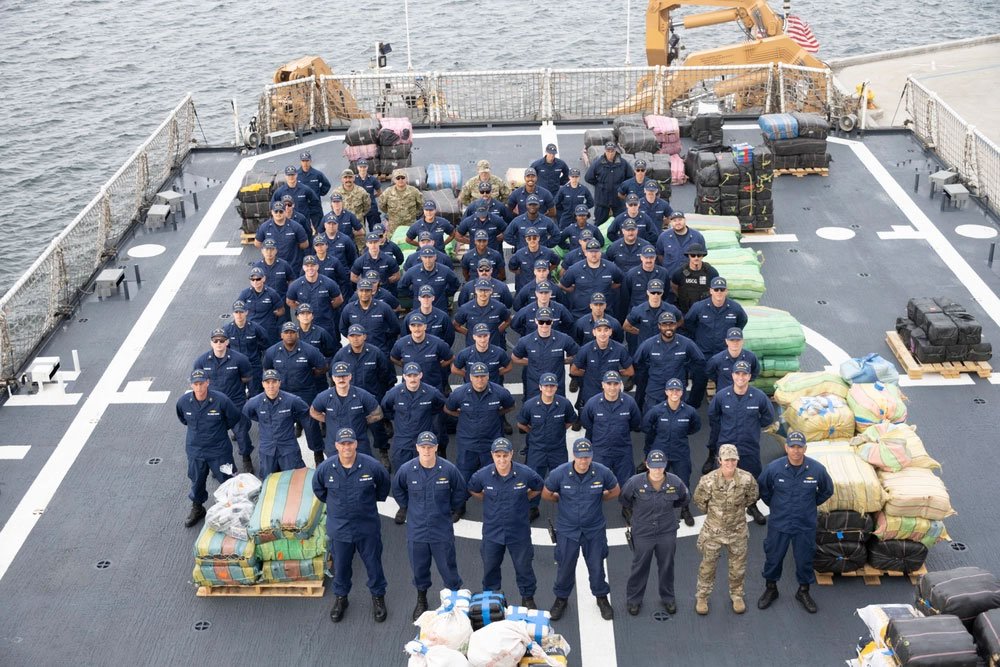Coast Guard Cutter Waesche (WMSL 751) crew offloaded more than 6,325 pounds of cocaine and more than 13,220 pounds of marijuana worth more than $166 million, Wednesday, in San Diego.
The five interdictions occurred in international waters in the Eastern Pacific Ocean off the coasts of Central and South America in February and March.
“The Coast Guard is dedicated to preventing illicit drugs from entering our country via the maritime environment,” said Rear Adm. Andrew Sugimoto, Eleventh District commander. ”These transnational criminal networks will be met on the water by our vigilant service members, like the crew of the Waesche, at every turn and brought to justice by the U.S. Attorney’s office.”
The counternarcotics were interdicted by the following U.S. Coast Guard cutters:
• Waesche’s crew was responsible for two interdictions seizing approximately 881 pounds of cocaine and 9,500 pounds of marijuana.
• Coast Guard Cutter Steadfast (WMEC 623) crew was responsible for one interdiction, seizing approximately 3,300 pounds of cocaine.
• Coast Guard Cutter Active (WMEC 618) crew was responsible for two interdictions seizing approximately 2,116 pounds of cocaine and 3,716 pounds of marijuana.
“This marks Waesche’s first counter-narcotics patrol in several years and the crew did an outstanding job to work with international and inter-agency partners to successfully prevent $166 million dollars’ worth of illicit drugs from entering our country, cities, and neighborhoods,” said Capt. Robert Mohr, commanding officer of the Waesche. “I am extremely impressed with the crew’s dedication throughout this dynamic patrol. They overcame multiple challenges with collective hard work, ingenuity, and positive attitudes to keep us in pursuit of these cartels and their dangerous drugs. I couldn’t be prouder of this remarkable crew and what they do to protect our communities.”
Numerous U.S. agencies from the Departments of Defense, Justice and Homeland Security cooperate in the effort to combat transnational organized crime. The Coast Guard, Navy, Customs and Border Protection, FBI, Drug Enforcement Administration, and Immigration and Customs Enforcement, along with allied and international partner agencies, play a role in counternarcotic operations.
The fight against drug cartels in the Eastern Pacific Ocean requires unity of effort in all phases from detection, monitoring, and interdictions, to criminal prosecutions by international partners and U.S. Attorneys’ Offices in districts across the nation. The law enforcement phase of counter-smuggling operations in the Eastern Pacific Ocean is conducted under the authority of the Eleventh Coast Guard District, headquartered in Alameda. The interdictions, including the actual boardings, are led and conducted by members of the U.S. Coast Guard.
“Like the United States Coast Guard and our other law enforcement partners, we are always ready to bring drug smugglers to justice in court,” said Sean P. Costello, United States attorney for the Southern District of Alabama. “Disrupting and dismantling the organizations responsible for transporting and distributing this poison remains among our highest priorities.”
The Waesche is the second Legend-class cutter of the U.S. Coast Guard and is homeported at Coast Guard Island in Alameda. The Waesche is 418 feet long with a top speed of 28 knots and a range of 12,000 nautical miles. It is equipped with a flight deck and hangars capable of housing two multi-mission helicopters, and outfitted with the most advanced command, control, and communications equipment.

